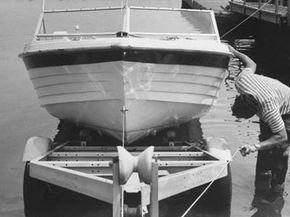Boat Launching Terms
Few hobbies have as deep a lexicon of jargon as boating. If you're new to boating, the terms and phrases other boaters use can seem overwhelming. Just learning the names for all the parts on a boat (or even a boat trailer) can be daunting. Let's dispense with some of that mystery right away and talk about the various equipment you'll need to work with when launching a boat.
We'll start with the boat itself. The main body of the boat is the hull. The front of the boat is the bow (also called the forward section or fore). There should be a place on the bow where you can secure a rope (or line, in boating terms). The correct term for such a rope is a bow line. Bow lines become very important during boat launches. The boat may also have a special bolt that allows the owner to attach a bow strap from the boat trailer to the boat, securing it in the front.
Advertisement
Another line that attaches to the bow of the ship is the boat trailer's winch line. Boaters use a winch to load the boat back onto the trailer. While winches can help secure a boat to a trailer, that wasn't their intended function. Many winch manufacturers warn boaters that their winches aren't rated to secure a boat to a trailer and could break if used that way. To secure a boat to a trailer safely, you should use straps and cables designed specifically for that purpose.
The back end of the boat is the stern (also called the aft). On the underside of the stern of most boats is a flat section of the hull called the transom. Many boats have transom eyes, which are special U-bolts that attach to the hull of the boat. Boaters can run a transom strap through these eyes to secure a boat to a trailer -- the strap passes through the transom eyes and attaches to the boat trailer on the port and starboard (left and right) sides.
Boats and docks have special fittings called cleats. The purpose of cleats is to provide a place for boaters to secure a line -- to make fast, in boating lingo -- from the boat to the dock. If you're launching a boat by yourself, you'll need to secure your boat to a dock after launching it. You don't want your boat floating off without you!
To protect the boat once it's in the water, most owners use either buoys, bumpers, fenders or a combination of the three. These are particularly important if you plan to launch a boat by yourself. Without protection, your boat could become damaged as it bumps against the dock or rocks in the water.
Because boats can sometimes take on water during operation, they have drains. Boat owners use plugs to close these drains while in the water, then remove the plugs once the boat is out of the water. Without the plugs installed, a boat will sink as water enters through the drains. It's also a good idea to have a bailer on hand -- a bucket you can use to dump water over the side of the boat if you take on too much.
Boat trailers often have rollers on them. Rollers are wheels that allow a boat to slide up or down a trailer without damaging it. Some trailers also have guide-ons, rails that help guide a boat into the right position during the loading process. It's kind of like the gutter guards you find at most bowling alleys.
Because you'll most likely be leaving your vehicle and trailer unattended while you're boating, it's a good idea to invest in coupler locks or tire locks. A coupler lock fits over the connection between your trailer and your vehicle, making it much more difficult for someone else to unhitch your trailer and abscond with it. Tire locks are similar to the boot devices police use to make sure the owner of an illegally parked vehicle can't drive away. Tire locks immobilize wheels.
Next, we'll take a look at the steps you'll need to follow to prepare for a boat launch.
